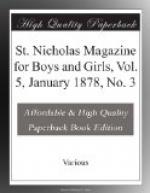[Illustration: EXTREMES MEET.]
Here the veterans, returned again to childhood, bask in the sun, and, watching the fort-building, forget their terrible campaigns amidst snows and burning sands, delighting to turn an end of the jumping rope or to trot a long-robed heiress on, perhaps, the only knee they have left.
[Illustration: THE STAFF OF LIFE.]
Parisians are very fond of uniforms, and so begin to employ them in the dress of citizens as soon as they make their entry into the world, even before they are registered at the mayor’s office; for the caps and cradles of a boy (or citoyen) are decorated with blue ribbons, and the girl (or citoyenne) with pink.
Every boys’ or girls’ school of any pretension has a distinctive mark in the dress, and so has each employment or trade,—the butcher’s boy, always bareheaded, with a large basket and white apron; the grocer’s apprentice, with calico over-sleeves and blue apron; and the pastry-cook’s boy, dressed in white with white linen cap, who despises and ridicules the well-blacked chimney-sweep, keeping the while at a respectful distance. And we must not forget the beggars, with their carefully studied costumes of rags, or the little Italians, born in Paris, but wearing their so-called native costume, which has been cut and made within the city walls.
The little ones of the outskirts of the city are generally independent and self-reliant youngsters, and sometimes, before they are quite steady on their feet, we meet them already doing the family errands, trudging along, hugging a loaf of bread taller than themselves. But the rosy plumpness of the fields is wanting; for children are like chameleons, and partake of the color of the locality they inhabit, so these poor little ones are toned down by the smoke and dust of the workshops. Their play-ground is under the dusty, dingy trees of the wide avenues; but they have the same games of romps their peasant mothers brought from their country homes, and above the noise of the passing vehicles we often hear their voices as they dance round in a circle, and sing verses of some old provincial song.
[Illustration: THE VETERAN AND HIS CHARGE.]
The delightful hours spent in boyhood, going to and from school, are unknown in the gay French capital to children of well-to-do parents. Instead of starting early and lingering on the way, they watch from the window until a black one-horse omnibus arrives, when a sub-master takes charge of the pupil, and the omnibus goes from house to house, collecting all the scholars, who are brought home in the same manner, the sub-master sitting next the door, giving no chance to slip out to ride on top, or to beg the driver to trust a fellow with the reins; and as it is the custom to obey all in authority, the master is respected. Girls are either sent to boarding-school or go to a day-school; in the latter case, always accompanied by one of their parents or a trusty servant.




